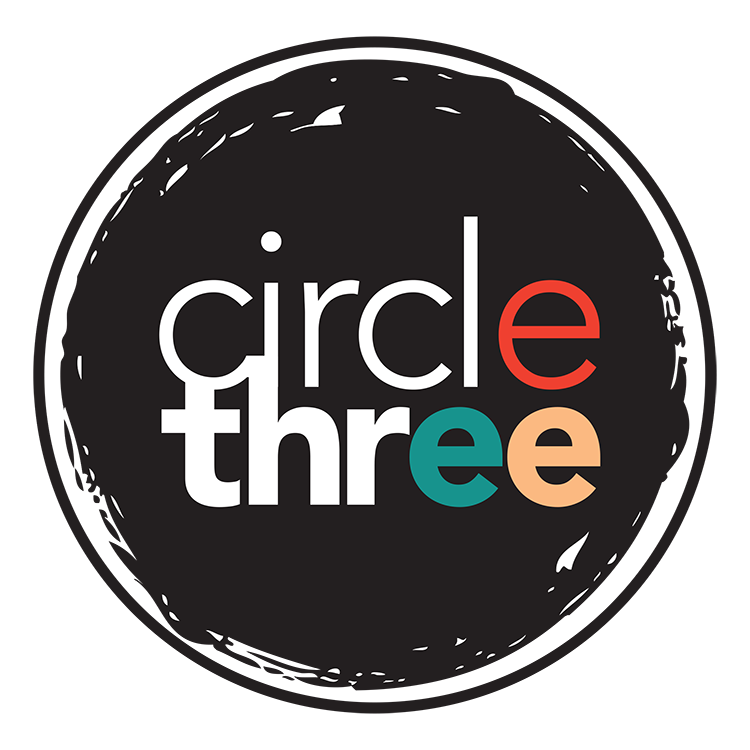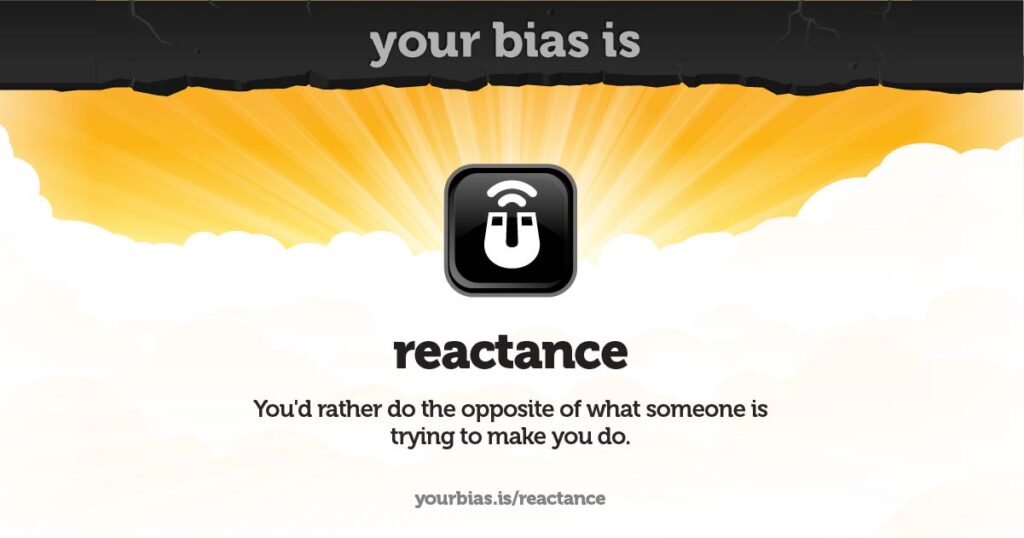This is one part in a series on Cognitive Biases and Logical Fallacies in marketing. Read more here.
Reactance is a psychological phenomenon* that occurs when people feel that their freedom of choice or autonomy is being threatened or restricted. When individuals perceive that their ability to make decisions or act freely is challenged, they often experience a negative emotional reaction, leading them to react in ways to assert their freedom.
This bias can manifest in various ways:
- Resistance: Individuals might actively resist or push back against perceived attempts to control or limit their choices. For instance, if someone is told they can’t do something, they might feel a strong urge to do it just to assert their freedom.
- Increased Desire: When a choice is restricted or forbidden, it can lead to an increased desire for the restricted option. This heightened desire is often a result of the perceived threat to freedom.
- Overcompensation: People might overcompensate by asserting their freedom in other unrelated areas. For example, if someone feels their freedom to express opinions is restricted, they might become overly vocal in expressing opinions on other matters.
- Reacting Defensively: Reactance can also lead to defensive behavior, where individuals try to justify or reinforce their freedom by defending their choices or beliefs more fervently.
Understanding reactance is important in various fields such as marketing, psychology, and communication, as it can influence how messages are received. For instance, overly forceful advertising that dictates what people should do or think can trigger reactance, leading to a negative response rather than compliance.
*So much of marketing is understanding psychology, so stick with me on this one! If you can motivate people by leveraging how their brain works, you can market well.
The Effect of Reactance on Business
Reactance can significantly impact business decisions and marketing strategies:
- Choice Overload: Too many options can overwhelm consumers, leading to reactance. When faced with an excessive number of choices, customers might feel their freedom constrained and might refrain from making a decision or, conversely, choose an option that seems to assert their freedom from the overwhelming choices.
- Forced Compliance: If marketing strategies come off as overly aggressive or coercive, customers might feel their freedom to choose is being threatened. This can lead to reactance, causing them to resist the marketing message or even the product itself.
- Negative Messaging: Messages that use fear or threats to persuade customers can trigger reactance. If consumers feel manipulated or pressured, they may react by avoiding the product or service being promoted.
- Restricted Access: Limited availability or exclusivity might trigger reactance. When customers feel they are being denied access or that their freedom to obtain a product or service is restricted, they might respond by wanting it more or by seeking alternatives.
- Intrusive Advertising: Overly invasive or interruptive advertising methods can provoke reactance. For instance, pop-up ads or aggressive email campaigns might make customers feel their autonomy is being compromised, leading them to resist the advertised products or services.
Businesses need to understand reactance to navigate these challenges. Marketers often employ strategies like providing personalized recommendations, simplifying choices, using softer language in persuasion, and respecting customer autonomy to reduce the likelihood of triggering reactance. By framing messages in a way that emphasizes choice, freedom, and empowerment rather than coercion, businesses can mitigate the negative effects of reactance and better engage with their target audience.
Let’s Fix It
To mitigate the effects of reactance and effectively market waste, recycling, or sustainability services, brands can employ several strategies:
- Education and Information Sharing: Provide clear, factual information about the benefits of recycling or sustainable practices without being forceful. Educate consumers about the positive impact of these actions on the environment and their lives.
- Empowerment and Choice: Frame messaging to empower consumers rather than dictate behavior. Emphasize that recycling or adopting sustainable practices is a choice that aligns with their values and gives them the power to make a positive impact.
- Personalization: Tailor messages to individual preferences and behaviors. Highlight how small changes in their habits can contribute to larger environmental goals. For instance, show how their recycling efforts directly impact the reduction of waste in landfills.
- Highlight Social Norms: Share information about the growing trend and societal shift towards sustainability. Emphasize that many people are adopting these practices, making it a social norm rather than an imposed rule.
- Positive Framing and Messaging: Focus on the positive outcomes of adopting sustainable behaviors rather than using negative or guilt-inducing language. Highlight success stories or the benefits that consumers can enjoy by participating in recycling or waste reduction programs.
- Engagement and Participation: Encourage active participation rather than passive compliance. Create interactive campaigns, challenges, or community events that involve consumers in the process of sustainability, making them feel part of a larger movement.
- Transparency and Honesty: Be transparent about the brand’s own efforts and commitments towards sustainability. Authenticity builds trust and can reduce reactance, as consumers feel the brand is genuinely aligned with their values.
- Ease of Adoption: Make it easy for consumers to participate in recycling or sustainability initiatives. Provide convenient and accessible options for recycling, waste reduction, or using sustainable products.
By implementing these strategies, brands can communicate their sustainability initiatives in a way that resonates positively with consumers, reducing the likelihood of triggering reactance and encouraging more widespread adoption of eco-friendly practices.
Interested in Learning More?
We’ll cover more cognitive biases and logical fallacies in upcoming blog posts, but if you’re eager to learn more and access free resources, check out School of Thought. If you’re interested in see how Circle Three Branding applies these to your marketing strategy, contact us.

